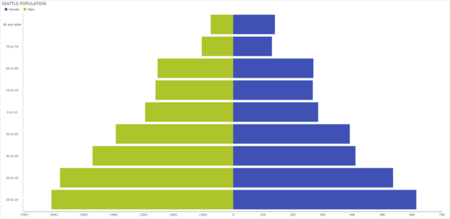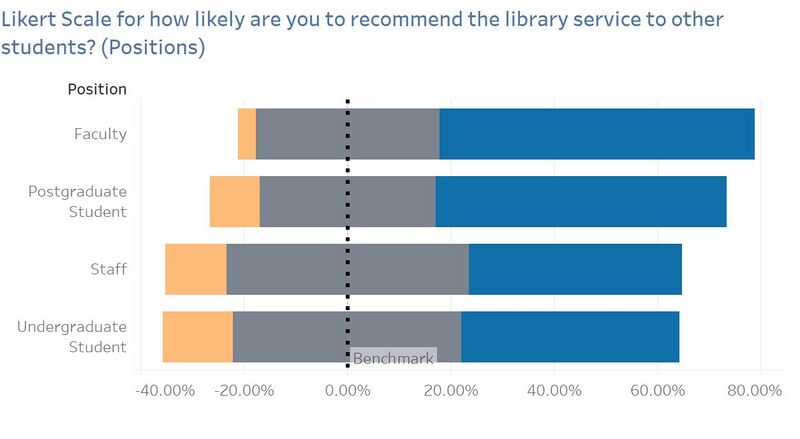Project Motivation
Project Objectives
Data Preparation
Every two years, SMU Libraries conducts a comprehensive survey in which faculty, students and staff have the opportunity to rate various aspects of our services. The survey provides SMU Libraries with input to help enhance existing services and to anticipate emerging needs of SMU faculty, students and staff.
In 2018, the library survey was conducted in February.
Selection of Graphs used in Data Visualization
| Graph Type
|
Reasoning
|
Picture
|
| Likert Scale
|
They are one of the most reliable ways to measure opinions, perceptions and Behaviours. It is used to an analysis survey question that uses a 5 or 7-point scale, in our Survey Data it uses 7-point scale and it referred to as a satisfaction scale, that ranges from Low (represented by 1) to High 7 (represented by 7).
|
|
| KPI Performance Chart
|
The KPI chart is used to, at a quick glance, give information about the current performance of the library. KPIs can be used to track the performance of the library against importance. They can provide a management tool for gaining insight and decision making. For our library survey data analysis is to identify the gaps between the importance and performance and in this case, both indicators are set by the survey responders. By looking at the gap we are able to identify if the library services currently under user's expectation or achieved user's expectation.
|
|
| Vertical Bar Chart
|
Use vertical column charts to display ordinal variables. For Net Promoter Score, it arranges ordinal categories from left to right so readers can view the sequence accordingly.
|
|
| Horizontal Bar Chart
|
Use horizontal bar charts to display nominal variables like Question ID. It allows arranging Question ID in a list from top to bottom and in a horizontal manner.
|
|
| Population Pyramid Chart
|
For Population Pyramid chart, breaks down SMU population into positions such as Undergraduate, Postgraduate, Staff and Faculty. For this assignment, you'll find the left side of the pyramid graphing the LKS population and the right side of the pyramid displaying the KGC population.
|
|
Overview
Survey Summary
| Picture Number
|
Description & Analysis
|
| 1
|
- It is clear that majority of the law students use Kwa Geok Choo Library (KGC) more often than Li Ka Shing (LKS) while Li Ka Shing library host more students from the Business School.
- We can see that the majority of the school population opt for Li Ka Shing library over Kwa Geok Choo library. This is probably due to the fact that LKS is located in the middle of the school compound and right next to campus green, making it more accessible for students as compared to KGC which is located at the far end of school with no sheltered walkway.
- LKS should allocate more books catered for the rest of the students while KGC can focus more law books which may come in handy. By allocating their services, can improve reputation.
|
| 2
|
- Using a Likert Scale to represent the Net Promoters Score where
- Blue represents ratings 9 and 10 (Promoters)
- Grey represents ratings 7 and 8 (Passive)
- Orange represents ratings 6 and below (Detractors)
- We can see that Faculty has the greatest number of promotors with Postgraduates following behind while Staff and Undergraduate student has the least promotors when it comes to recommending library services to other students.
- Since undergraduate students comprise of the majority usage of LKS and being the ones who use it daily, LKS should focus on improving their services. In SMU majority of the population are come from undergraduate students, if the library wants to increase the Net Promoter Score they should pay more attention to undergraduate students.
|
| 3
|
row 3 cell 2
|
| 4
|
row 4 cell 2
|
Gap Analysis Explanation
Summary
- The highlight table shows the percentage breakdown of rating for both importance and performance for each group – Undergraduate, Postgraduate, Staff and Faculty.
- Conducting a gap analysis where we take the Performance minus the Importance to find the gap between the importance of the question to them and compare it to how the library performs.
- Since Importance is defined as how important it is to that individual and performance is defined as how well the library is performing in that area.
- We will take the difference between these two, to measure how well the library is performing when compared to the level of importance held to them.
- If the gap analysis turns out positive, it means that performance has exceeded importance. If it turns out negative, it means that performance has not met the same ranking as importance. And this is one key aspect the library should look at when improving their services.
- I will be picking out 1 major change in each group for each category – Undergraduate, Postgraduate, Staff and Faculty and the rest can be viewed on Tableau Public.
Undergraduate
Gap Analysis
| Picture Number
|
Description & Analysis
|
| 1
|
|
| 2
|
|
| 3
|
|
| 4
|
|
| 5
|
|
| 6
|
|
| 7
|
|
Postgraduate
| Picture Number
|
Description & Analysis
|
| 1
|
|
| 2
|
|
| 3
|
|
| 4
|
|
| 5
|
|
| 6
|
|
| 7
|
|
Faculty
| Picture Number
|
Description & Analysis
|
| 1
|
|
| 2
|
|
| 3
|
|
| 4
|
|
| 5
|
|
| 6
|
|
| 7
|
|
Staff
| Picture Number
|
Description & Analysis
|
| 1
|
|
| 2
|
|
| 3
|
|
| 4
|
|
| 5
|
|
| 6
|
|
| 7
|
|
Data Reference






